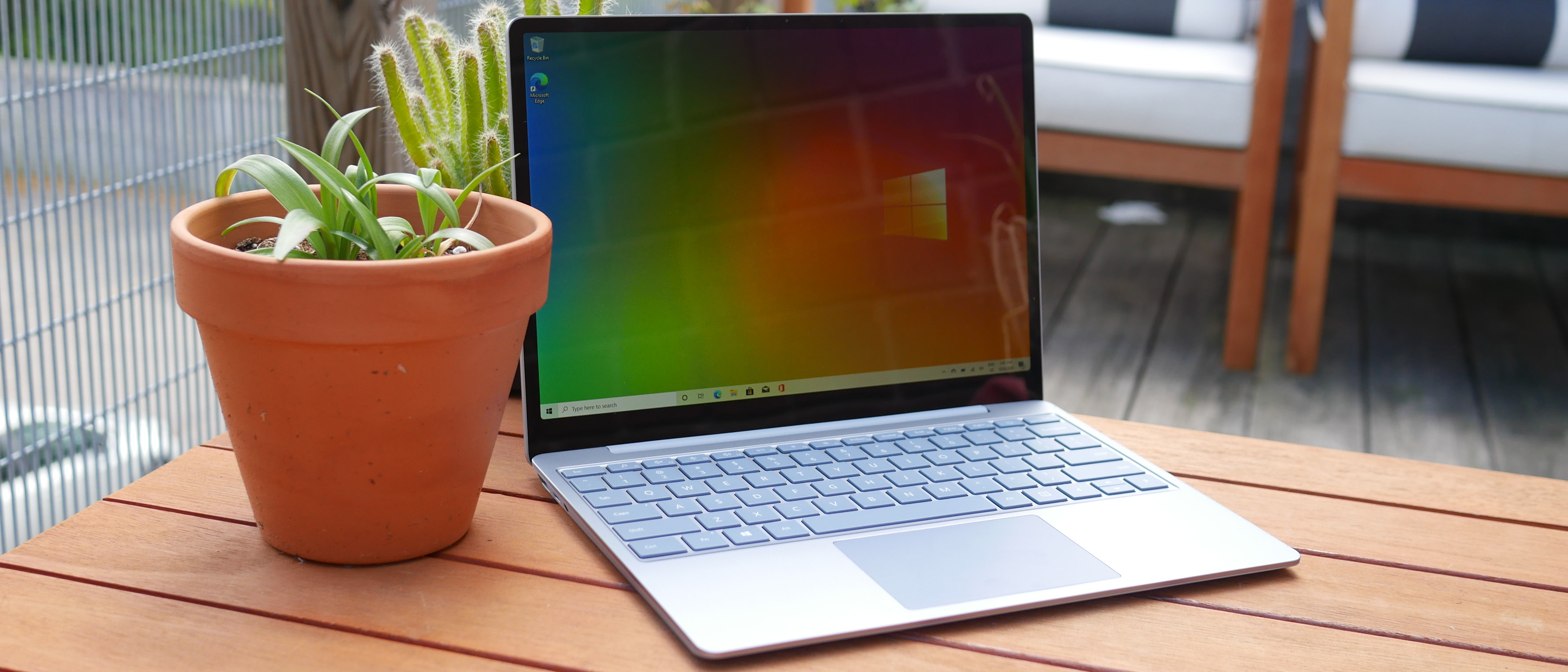Laptop Mag Verdict
Microsoft's Surface Laptop Go is a near-perfect mid-range laptop with a battery life problem.
Pros
- +
Stylish, premium design
- +
Class-leading keyboard
- +
Great 12.4-inch display
- +
Thin bezels; 3:2 aspect ratio
Cons
- -
Subpar battery life
- -
Keys aren't backlit
- -
Base specs underwhelm
Why you can trust Laptop Mag
Price: $899 (starts at $549)
CPU: Intel Core i5-1035G1 CPU
GPU: UHD graphics
RAM: 8GB
Storage: 256GB SSD
Display: 12.4-inch, 1536 x 1024-pixel
Battery: 7:42
Size: 11 x 8.1 x 0.6 inches
Weight: 2.5 pounds
With the Surface Laptop Go, Microsoft breaks from the premium-only strategy employed by Apple to bring consumers a more affordable option. It is, dare I say, a courageous move, engineering a mainstream laptop that adheres to the principles of Microsoft's pricier Surface products.
In the end, Microsoft made the right choices when deciding how to keep the price down. Most* of the tradeoffs are easily overlooked, allowing the more premium aspects of the Surface Laptop Go to shine.
- Best college laptops in 2020: Best laptops for students
- Best Ultrabooks in 2020
The laptop flaunts a gorgeous design that effortlessly blends aluminum with a unique soft-touch plastic. The 12.4-inch display, aided by a useful 3:2 aspect ratio, is great for work or play, while the keyboard is nothing short of class-leading.
The asterisk next to "most" leads us to the few areas where Microsoft's decision-making faltered: the Surface Laptop Go's keyboard isn't backlit and we wouldn't recommend the base model given the specs. Also, consider the Laptop Go's subpar battery life and the laptop Microsoft built for all suddenly becomes a laptop only good for some.
Surface Laptop Go price and configuration options
Microsoft's least expensive laptop, the Surface Laptop Go starts at $549. It's a headline-capturing price for sure, but the base model underwhelms on the specs sheet with an Intel Core i5-1035G1 CPU, 4GB of RAM and 64GB of eMMC storage.
We recommend, if your budget allows it, upgrading to the $699 mid-tier model which gets you 8GB of RAM and a 128GB SSD. Our $899 review unit, the priciest of the bunch, doubles the storage to 256GB.
Surface Laptop Go design
Coming from the same family as the Surface Laptop, the Laptop Go shares (most of) its DNA. What few compromises were made to this cheaper model were sensibly considered so as to retain the sleek minimalism and premium materials that define Microsoft's products.
Sign up to receive The Snapshot, a free special dispatch from Laptop Mag, in your inbox.

When viewed from above, the Laptop Go looks like a smaller version of the Surface Laptop 3, sporting an aluminum lid (shown in Ice Blue) adorned with a chrome Microsoft logo in the center. Turn the laptop upside down and the difference becomes obvious.
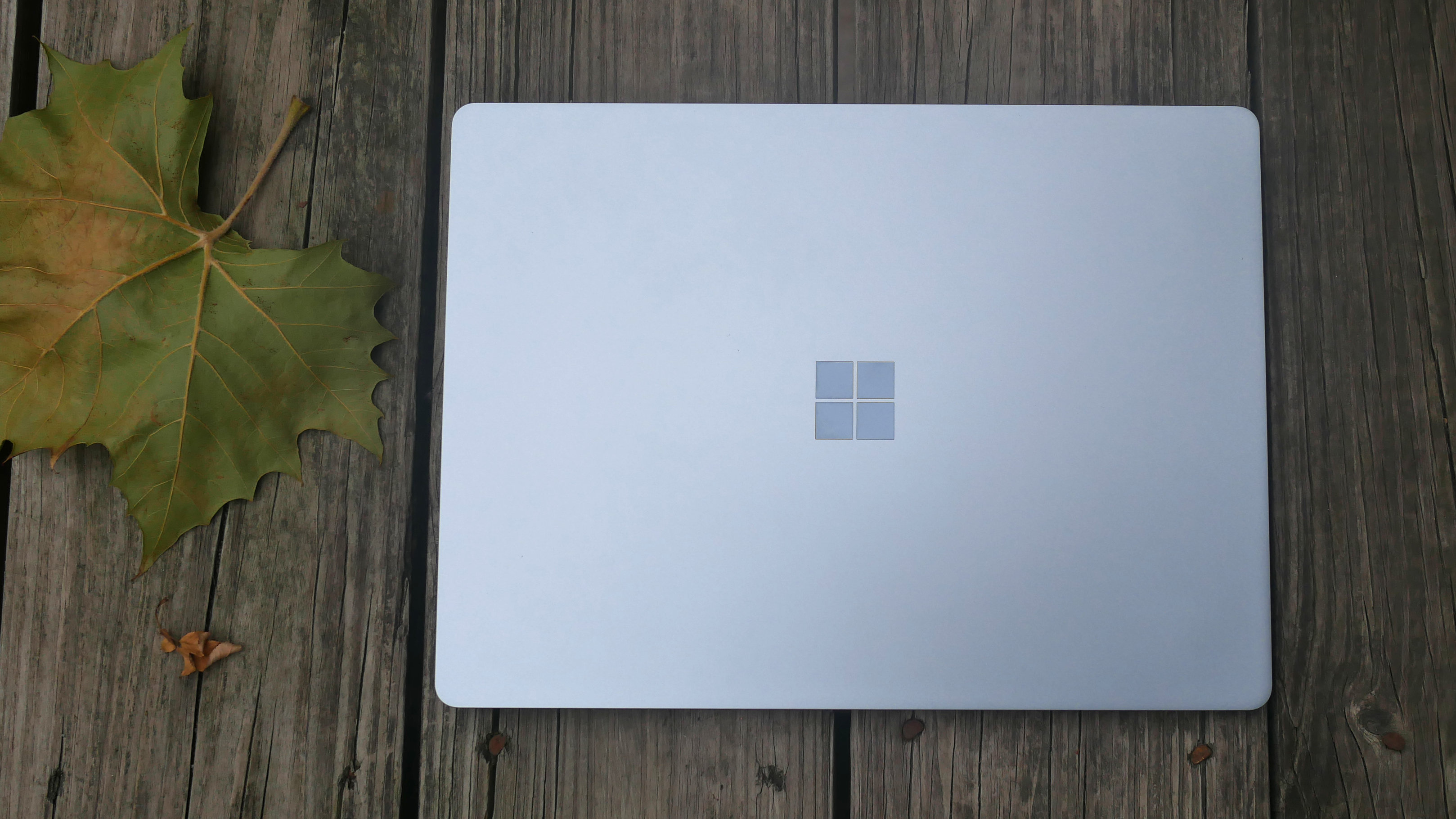
The Surface Laptop Go trades the Surface Laptop 3's aluminum bottom cover for one made of polycarbonate resin. More specifically, the underside is made of 40% glass fiber and 30% post-consumer recycled materials. Plastics can feel cheap, but not in this case — the Laptop Go's bottom panel is covered in a pleasant soft-touch finish.
Nothing on the inside of the Laptop Go suggests it's any less expensive than the most premium ultrathin options. Aluminum returns on the deck when you open the laptop, creating a soft-hard contrast with the light-gray touchpad and keys. Elevating the Laptop Go's design are the thin bezels around the display, a feature usually found on much pricier models. Combined with a sleek footprint and elegantly sloped lines, the Surface Laptop Go is, without question, among the best-looking laptops in this price range.

The Laptop Go's rubbery bottom panel isn't only a price-cutting measure, it also keeps the laptop's weight down. At 11 x 8.1 x 0.6 inches and 2.45 pounds, the Surface Laptop Go is lighter than Asus' ZenBook 13 UX325UA (11.9 x 8 x 0.5 inches, 2.5 pounds) and the HP Envy x360 13 (12.1 x 7.7 x 0.7 inches, 2.9 pounds) but heavier than the Pixelbook Go (12.2 x 8.1 x 0.5 inches, 2.3 pounds) and, understandably, the Surface Go 2 (9.7 x 6.9 x 0.3 inches, 1.6 pounds (with Type Cover)).
Surface Laptop Go ports

Ports are scarce but the most commonly used inputs are all here. On the left side of the laptop are a USB 3.1 Type-A port, a USB Type-C input and a headphone jack.

Alone on the right side of the laptop is a magnetic Surface Connect port for charging.
Surface Laptop Go display
"Oh, the display isn't that small!" I remember saying to my wife the first time I powered on the Surface Laptop Go. The 12.4-inch, 1536 x 1024-pixel display has a 3:2 aspect ratio, so the screen is taller but more narrow than standard 16:9 panels. The ratio allows you to view more content on websites, in spreadsheets, or other text-heavy applications. I enjoyed watching YouTube videos and Netflix shows just as well — the thin letterbox bars above and below the videos didn't take away from the picture quality.

Speaking of which, the Surface Laptop Go's display doesn't disappoint. It's vivid and objects and text look sharp despite the screen's relatively low resolution. I could see each shard of glass fall to the ground around Ryan Reynolds during a bank holdup scene in the trailer for Free Guy. The actor's endearing blue shirt contrasted with the fiery orange explosions, crimson red blood and neon lights of the fictional video game world he finds himself in.
The touch panel was responsive to my swipes and taps as I navigated Windows 10 with my fingers. Without stylus support or a flexible 2-in-1 chassis, the touchscreen has limited use, but it's nice to scroll through online shopping pages and some of my favorite sites by simply swiping down.
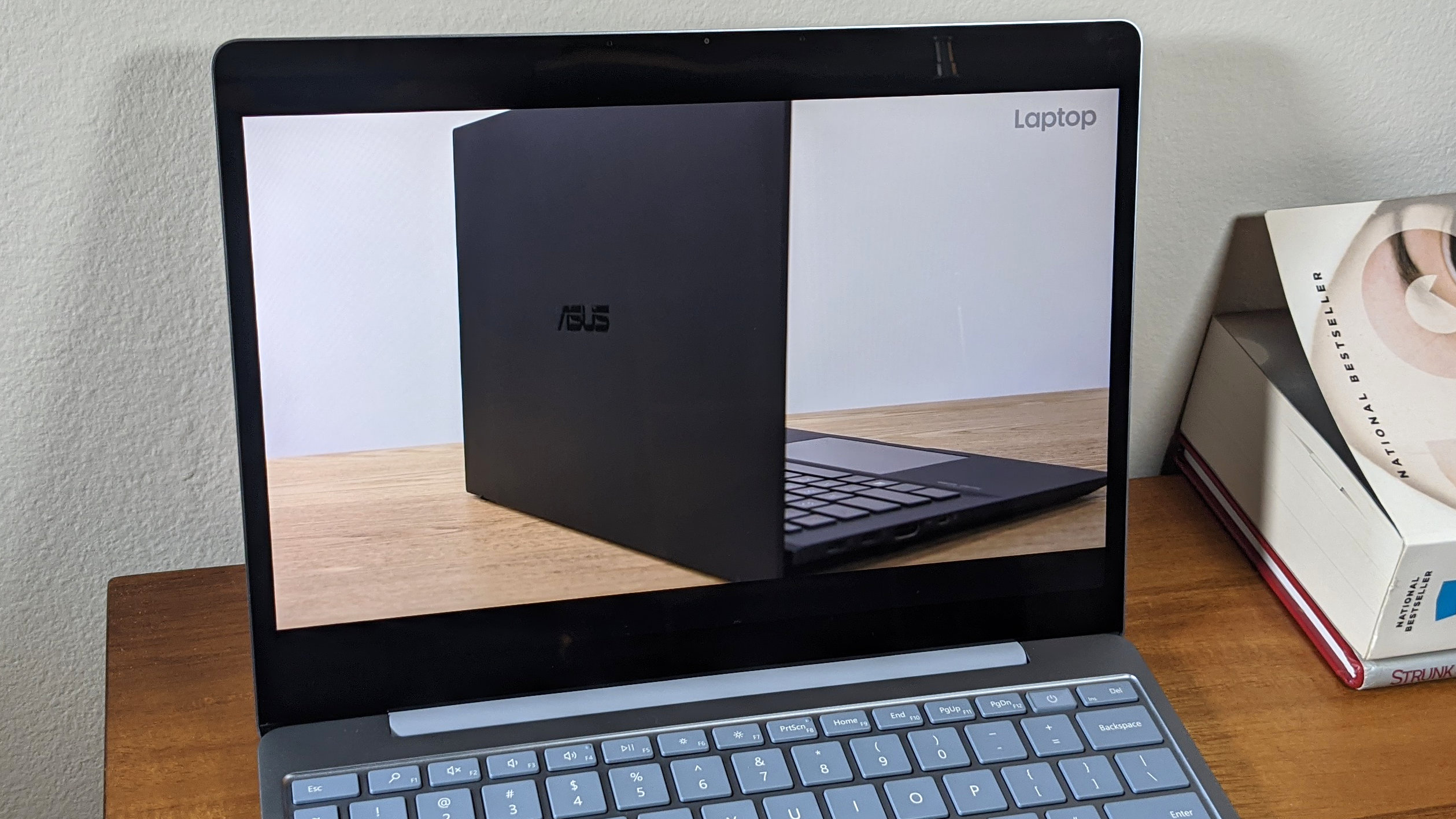
According to our colorimeter, the Surface Laptop Go's screen covers 77% of the DCI-P3 color gamut, making it about as vivid as the displays on the ZenBook 13 UX325EA (76%), the Pixelbook Go (77%), Surface Go 2 (76%) and the Envy x360 13 (76%). It is more colorful than the average mainstream laptop (67%).
The display reaches a peak brightness of 319 nits, a decent result but dimmer than competitors, including the ZenBook 13 UX325EA (370 nits), Surface Go 2 (408 nits), PixelBook Go (368 nits), Envy x360 13 (364 nits) and the category average (301 nits).
Surface Laptop Go keyboard and touchpad
I've gushed about Microsoft's Surface keyboard in previous reviews, so I was happy to see it return on the Surface Laptop Go. The Chiclet-style keys are so bouncy that my fingers effortlessly jumped from one letter to the next. And with 1.3 millimeters of travel, the keys have a satisfying tactility I didn't expect on a laptop this small.
I also like how the frost keys color-match the deck; it gives the Surface Laptop Go a more cohesive aesthetic than the MacBook Air, which comes with black keys regardless of the exterior color.

I typed at a blistering 118 words per minute with a 95% accuracy on the 10fastfingers.com typing test, outpacing my 109 wpm average at the same error rate.
Now onto the bad news. This where Microsoft made its first error when deciding what corners it would cut to keep the Surface Laptop Go's price down: The keyboard is not backlit.

At the $549 base price, the lack of keyboard backlighting isn't a major offense. But when you consider our $900 config, which competes against the Pixelbook Go and HP Envy x360 13, a backlit keyboard should be a given; I wouldn't blame hunt-and-peck typers for having doubts about the Surface Laptop Go because of the omission.
The only illuminated key on the Laptop Go is the fingerprint sensor. A bright white LED bordering the key guides you to the biometric scanner so you can quickly login via Windows Hello. The fingerprint sensor worked flawlessly in my testing, registering my finger instantly and saving my scatterbrained-self the frustration of remembering my password.
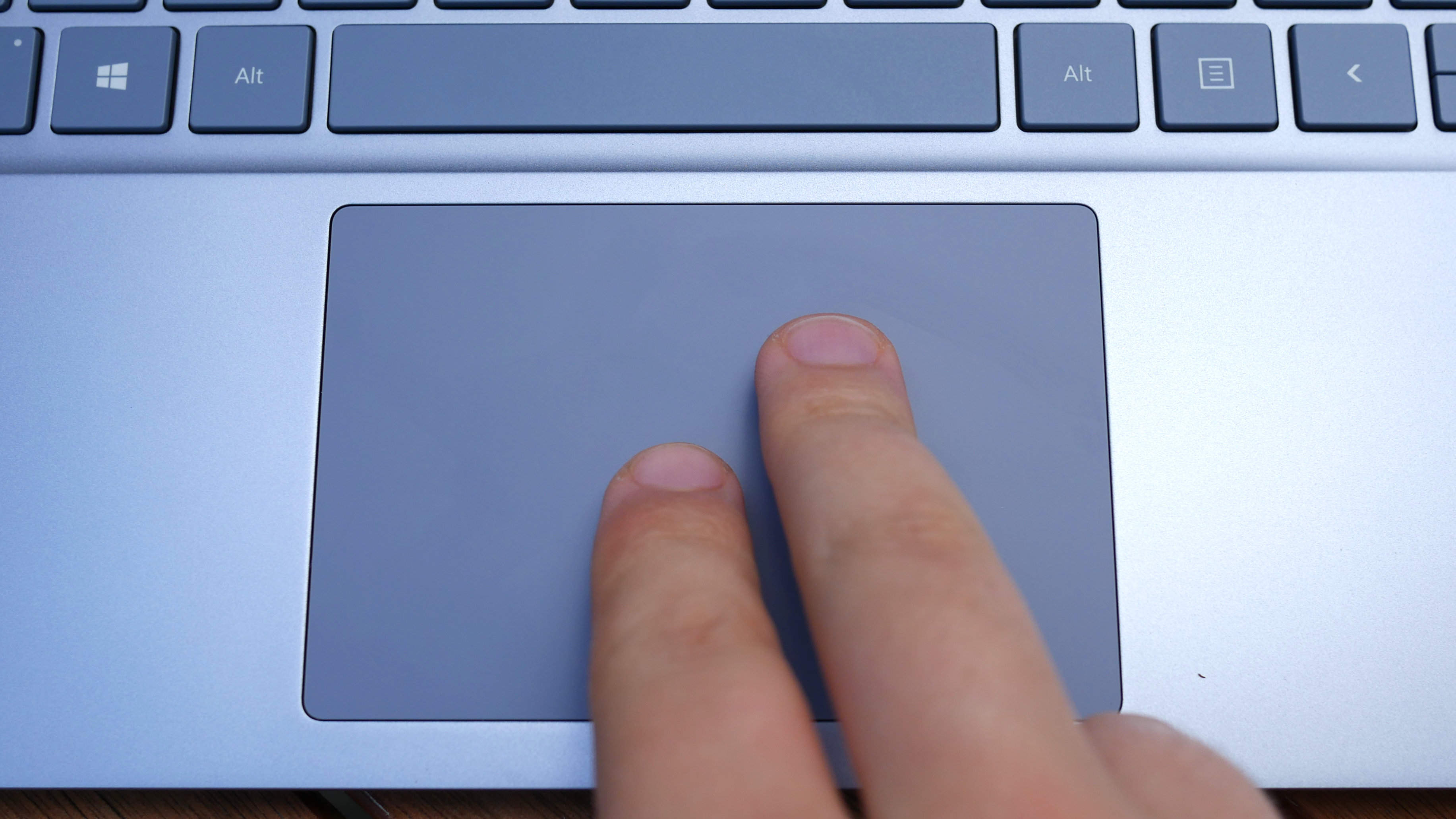
The 3.9 x 2.6-inch glass touchpad feels silky smooth and kept up with my erratic swipes as I moved my cursor across different windows and used two-fingers to scroll down sites. Thanks to the Precision drivers, the touchpad never lagged behind or had problems executing more complicated Windows 10 gestures, like three-finger swipes to flip between open apps.
Surface Laptop Go audio
"Where is the sound coming from?" you might wonder when listening to jams on the Surface Laptop Go. Like the Surface Laptop 3, the dual "omnidirectional" speakers on the Laptop Go are located underneath the keyboard.
The speakers are impressive if you keep them below maximum volume. Leon Bridges and Khruangbin's "Texas Sun" filled my living room, but the twang of the electric guitar in this country-meets-soul song was piercing and distorted at 100% volume.
The Killers' "Read My Mind" sounded crisp and the cacophony of electric instruments was handled deftly, each slide of the guitar separated from the others; I just wish the low end had more oomph to give the song the energy it deserves.
Surface Laptop Go performance
Another way Microsoft kept the price down is by opting for Intel 10th Gen CPUs instead of the new 11th Gen "Tiger Lake" processors. As such, the Surface Laptop Go misses out on the new Iris Xe graphics. It's also worth noting that there is no AMD Ryzen version of this laptop. Microsoft turned to AMD a year too soon with the Surface Laptop 3, but I'd have welcomed the chipmaker's outstanding Ryzen 4000-series CPUs this time around.
Regardless, our review model, configured with an Intel Core i5-1035G1 CPU and 8GB of RAM, was quick to load 20 tabs in the new Microsoft Edge browser, two of which played 1080p YouTube videos while another pair streamed Twitch. Websites took a few beats longer to load than they do on premium models I've tested, but I didn't encounter any crashes or significant lag. Even quick photo editing in Pixlr with those tasks running in the background didn't trip up the Surface Laptop Go.
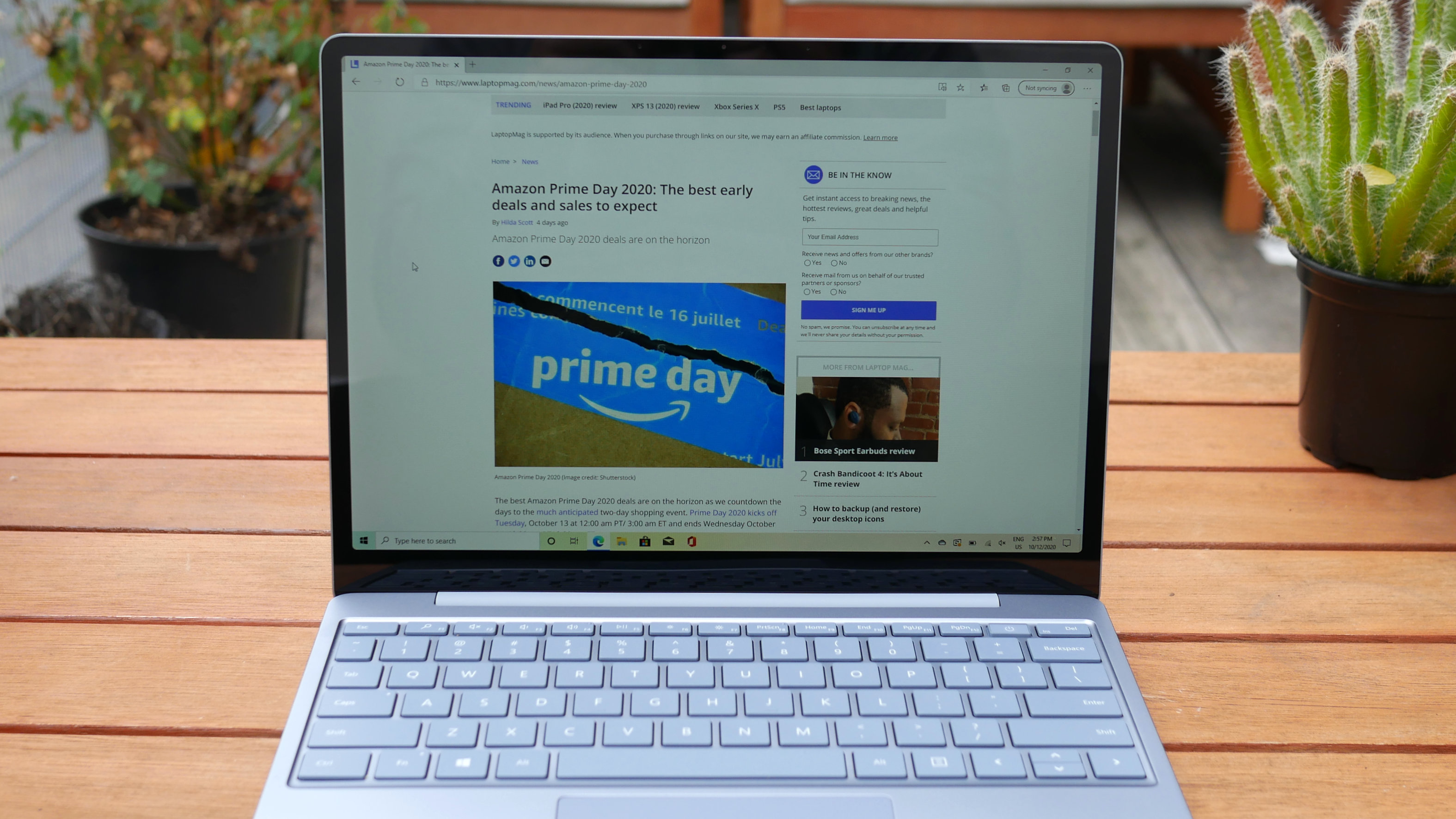
With a Geekbench 5.0 score of 3,117, the Surface Laptop Go lagged behind the Envy x360 13 (4,617, Ryzen 5 4500U) and the ZenBook 13 (5,084, Core i7-1165G7). But it embarrassed the Intel Y-series CPU-powered Surface Go 2 (1,563, Core m3-8100Y) and the Pixelbook Go (1,356, Core i5-8200Y).
It took the Surface Laptop Go 25 minutes and 55 seconds to convert a 4K video to 1080p using the Handbrake app. That same task was accomplished by the ZenBook 13 in 17:51 while the average mainstream laptop wraps things up in 20:29. Of its closest competitors, only the Surface Go 2 fell behind, needing 48 minutes and 14 seconds.
The $200 Microsoft charges to upgrade from a 128GB to a 256GB SSD would be warranted if the storage wasn't so slow. On our file transfer test, it took the Surface Laptop Go 1 minute and 39 seconds to convert 25GB of multimedia files, equating to a ho-hum transfer rate of 266.3 megabytes per second. Asus' ZenBook 13 (583.6 MBps, 1TB M.2 PCIe) finished in less than half the time while the Envy x360 13 (318.1 MBps, 256GB PCIe NVMe M.2) and the average mainstream laptop (423.7 MBps) also outpaced the Laptop Go. Microsoft's Surface Go 2 (163.7 MBps, 128GB NVMe SSD) tablet proves the company uses sluggish components.
Surface Laptop Go graphics
Unlike the higher-end 10th Gen CPUs (which are paired with Iris Plus graphics), the Core i5 in the Surface Laptop Go uses Intel UHD graphics. With renewed efforts from Intel and AMD to deliver significant graphics gains in the newest chips, UHD will soon be an unmissed relic.
Our benchmark scores show why we're anticipating the end of the UHD Graphics era. The Surface Laptop Go "ran" Sid Meier's Civilization VI: Gathering Storm at an unplayable 9 frames per second. The ZenBook 13 with Iris Xe graphics hit 23 fps while the Envy x360 13 with AMD Radeon graphics notched 27 fps. Also leaning on UHD graphics, the Surface Go 2 (5 fps), struggled just as much as the Surface Laptop.
Surface Laptop Go battery life
Damn, this one hurts. Until our battery test (continuous web surfing over Wi-Fi at 150 nits), the Surface Laptop Go was destined for mid-range laptop greatness. But with 7 hours and 42 minutes of runtime, I struggle to recommend it ahead of its competitors. Those rivals, the Pixelbook Go (11:29), ZenBook 13 UX325UA (13:47), Surface Go 2 (11:39) and Envy x360 13 (11:51), lasted for several hours longer.
We ran this test three times; the Surface Laptop Go never topped 8 hours of runtime.
Surface Laptop Go webcam
The 5 megapixel, 1080p webcam on the Surface Pro X was a refreshing change from the terrible cameras we're used to on laptops and tablets. Unfortunately, the 720p lens on the Surface Laptop Go is a return to the disappointing norm. A selfie I snapped on a lovely fall day was shrouded in grainy dots, or visual noise.

I couldn't even see strands of hair in my beard, which looked like a brownish blob. My hoodie was the appropriate shade of gray and the lens captured the peach and rose tones in my face, but I recommend an external webcam if you want to look your best on the next conference call with the boss.
Surface Laptop Go heat
The soft-touch bottom panel is only comfortable to touch when the laptop isn't being taxed. During our heat test, which involves playing a 15-minute HD video, the underside ran a 112 degrees Fahrenheit temperature. Other parts of the laptop, like the center of the keyboard (96 degrees) and the touchpad (83 degrees), fared better.
Surface Laptop Go software and warranty
Click on the Start Menu and smell the fresh scent of pure Windows 10. There's none of that musky bloatware taking up valuable space on the Surface Laptop Go's SSD. That said, Microsoft still brings the standard fare of pre-installed Windows apps, like Your Phone, Xbox Game Bar and several Windows admin tools.
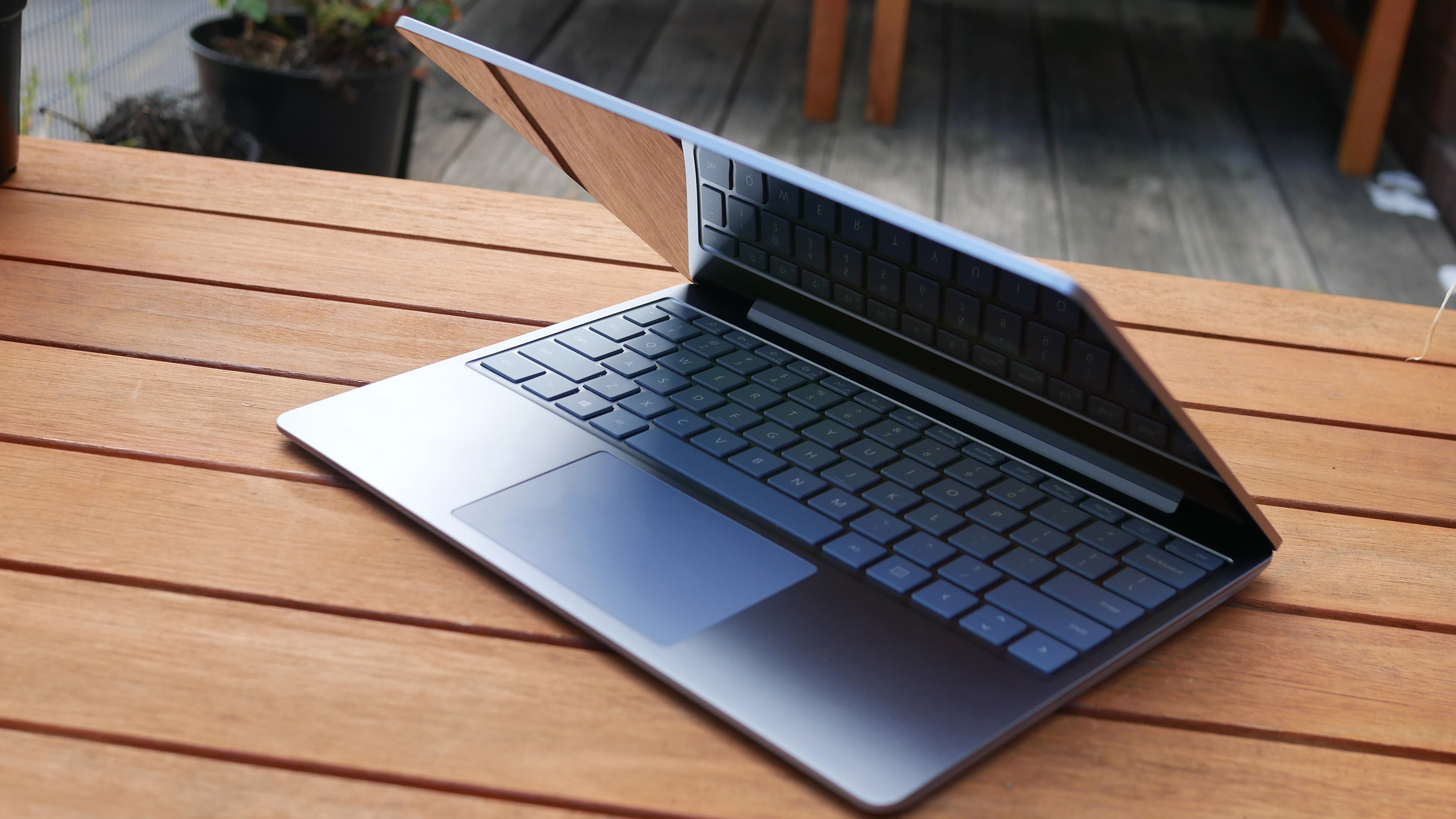
No, I can't get myself to ignore the elephant in the room: S Mode. Why it's ever enabled by default escapes me, but alas, it is on the Laptop Go. In short, S Mode increases security by restricting you to apps in the Microsoft Store and requiring the Edge browser. We've written a lot about S Mode in the past and concluded that not a lot of people will want it. Microsoft knows that and gives you the option to switch out of it for free — just be warned, once you go full Windows 10, you can't go back.
The Surface Laptop Go ships with a one-year warranty. See how Microsoft fared on our annual special reports: Tech Support Showdown and Best and Worst Brands.
Surface Laptop Go: Verdict
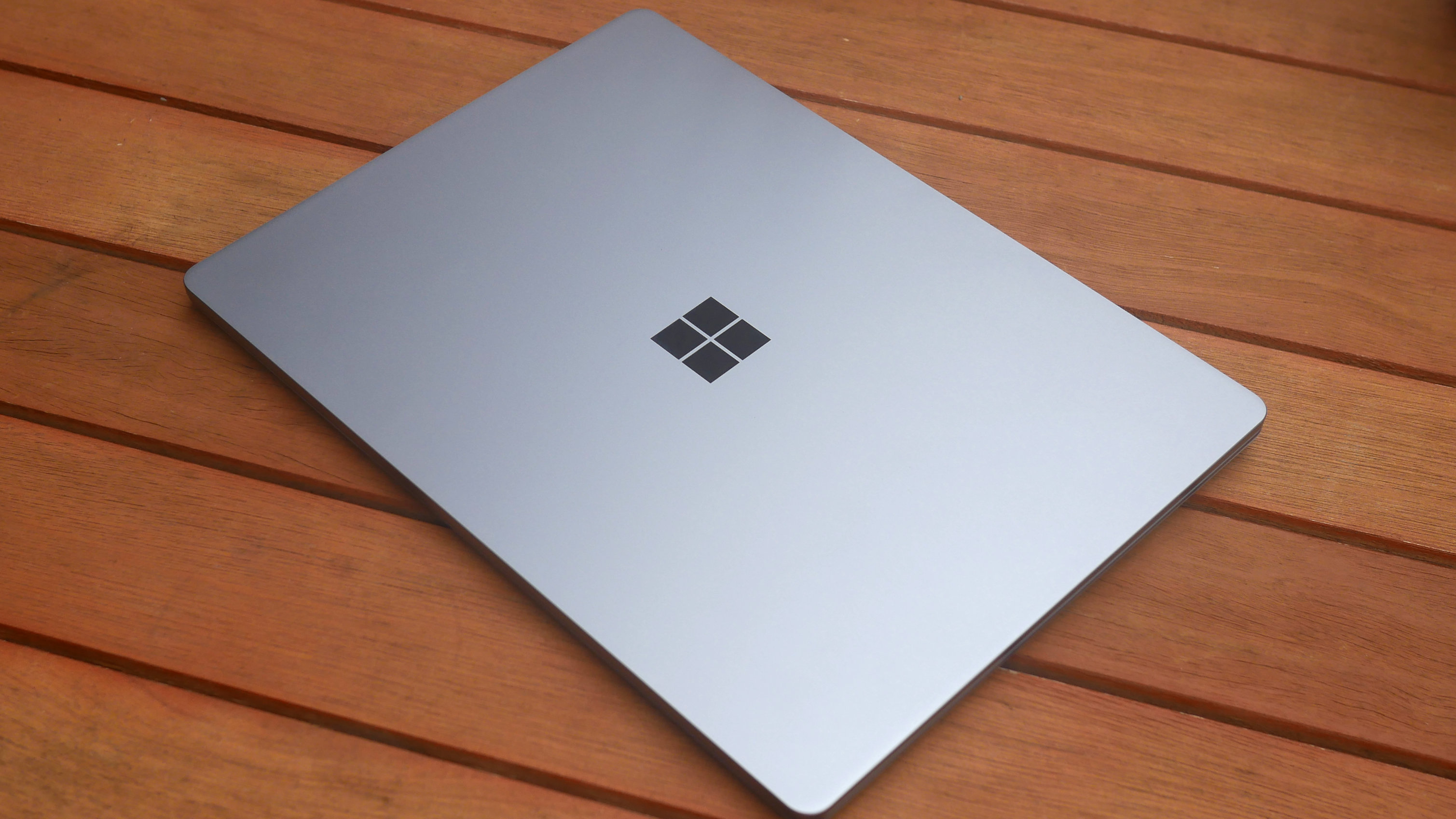
I admire the concept behind the Surface Laptop Go. We too often shine the spotlight on the most expensive products when most consumers can get a perfectly capable laptop for under $1,000. What the Surface Laptop Go brings to the table is one of, if not the most, elegant designs in this price range. A few trade-offs were made to keep the price down, but those don't prevent the Surface Laptop Go from feeling any less expensive than the MacBooks and XPSs of the laptop world.
Combine the classy design with a great 12.4-inch display in a 3:2 aspect ratio, a fantastic keyboard and quick performance, and the Surface Laptop Go is a compelling option for those who want a premium product at a not-so-premium price. With everything it has going in its favor, it's a shame the Surface Laptop Go's battery life is so far behind the competition. I also feel Microsoft made a few too many concessions between the non-backlit keyboard and subpar 720p webcam.
Because of these shortcomings, the Surface Laptop Go falls behind the HP Envy x360 13 as the best sub-$1,000 laptop on the market. The $799 Envy is fueled by powerful AMD Ryzen CPUs, it lasts nearly 12 hours on a charge, and it has a stylish chassis. For a bit more money, you can get Asus' ZenBook 13 UX325EA, a $999 ultrathin with few shortcomings. Those who are OS agnostic should also consider the $849 Pixelbook Go; while its performance lags behind, Google's Chromebook is ultra-lightweight and lasts a full day on a charge.
So yes, there are better options than the Surface Laptop Go. However, if portability is a priority, and you want to save money on a laptop that feels no less expensive than other flagship models, then the Surface Laptop Go is the one to buy.
Phillip Tracy is the assistant managing editor at Laptop Mag where he reviews laptops, phones and other gadgets while covering the latest industry news. After graduating with a journalism degree from the University of Texas at Austin, Phillip became a tech reporter at the Daily Dot. There, he wrote reviews for a range of gadgets and covered everything from social media trends to cybersecurity. Prior to that, he wrote for RCR Wireless News covering 5G and IoT. When he's not tinkering with devices, you can find Phillip playing video games, reading, traveling or watching soccer.
